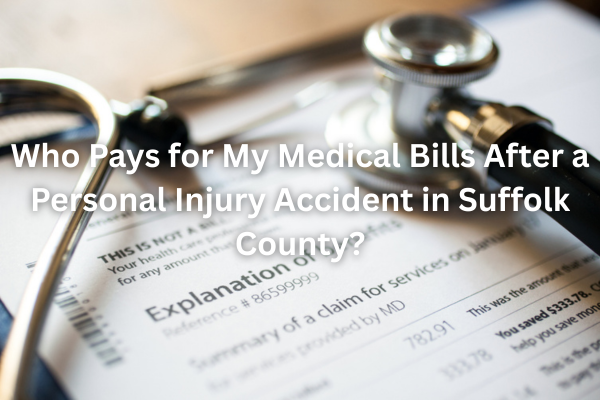

If you’ve been hurt in a crash or a fall on Long Island, the first shock is the injury itself. The second shock? Watching medical bills arrive while you’re still trying to heal. ER charges, imaging, specialist visits, physical therapy, prescriptions—costs stack up fast. The good news is you’re not limited to just one source of payment. In New York, multiple “buckets” can help cover care, and in many cases the order they’re used matters. Here’s a clear, Suffolk-County-specific roadmap.
For most motor vehicle accidents, New York’s No-Fault (Personal Injury Protection or “PIP”) is your first line of payment regardless of who caused the crash. PIP generally covers reasonable and necessary medical treatment, a portion of lost wages, and some incidental costs up to the policy’s limit (often $50,000, sometimes more if optional benefits were purchased).
You must file a No-Fault application quickly (typically within 30 days of the crash). Missing deadlines can risk denial. Give every provider your No-Fault claim information so bills route to the correct insurer from day one. If your injuries are serious, PIP alone may not be enough. That’s where other sources come in.
Once PIP is exhausted, or if a claim is denied in part, your private health insurance, union plan, or Medicare/Medicaid may step in. A few things to keep in mind:
Some auto policies include Medical Payments (“Med-Pay”) coverage. It can function like a small cushion on top of PIP, paying medical costs regardless of fault. If you have it, we’ll help you tap it strategically to reduce out-of-pocket exposure.
If you were driving for work or injured while performing job duties, workers’ compensation is usually primary for medical care. It pays authorized treatment and may offer wage benefits. Comp carriers also seek reimbursement from at-fault parties, which affects settlement strategy—another reason coordination matters.
When someone else’s negligence caused your injuries—an unsafe property, a distracted driver, a negligent dog owner—you can pursue a bodily injury claim. This is separate from PIP. That claim can recover:
Important: The at-fault carrier does not pay your bills as they arrive. They typically pay once, either through settlement or judgment, after treatment stabilizes or your attorney is ready to present the full picture of damages. Until then, the immediate payment sources are PIP, health insurance, Med-Pay, or workers’ comp.
This happens. Some offices don’t take No-Fault or comp. You still have options:
Ambulances and ERs often bill No-Fault first. If they accidentally bill you or your health plan, notify us so we can redirect it. Keep copies of every bill and any collection letter—early intervention prevents credit headaches.
New York has protections against balance billing in emergencies and certain out-of-network scenarios. If you’re seeing confusing “balance due” notices while an insurer should be paying, we can review the situation, dispute improper balances, and make sure the right payer is being billed.
When PIP, health insurance, Medicare, Medicaid, or workers’ comp pays for your care, they may have a legal right to reimbursement from your settlement. The rules are technical and vary by payer:
Handled well, liens are negotiated and resolved from the settlement, so you aren’t left paying twice. Handled poorly, they can delay or reduce your net recovery. We build lien strategy into your case plan from day one.
Two common scenarios:
If you contact us quickly, we’ll protect these deadlines while you focus on healing.
We’ve represented Suffolk County injury victims for over three decades. Our approach is simple and proactive:
After a Suffolk County personal injury, multiple payers may be responsible for your medical bills—starting with No-Fault for car crashes, then health insurance, Med-Pay, or workers’ comp as applicable, and ultimately the at-fault party through settlement or verdict. The order and strategy matter. With the right plan, you can keep treatment moving, protect your credit, and preserve the value of your claim.
If you’ve been hurt and medical bills are piling up, let’s talk. Palermo Law has helped Long Island families for over three decades. We’ll sort the coverage, handle the paperwork, and fight for the full compensation you deserve so you can focus on getting better. Contact us at (631) 621-6183 or fill out our confidential online form.